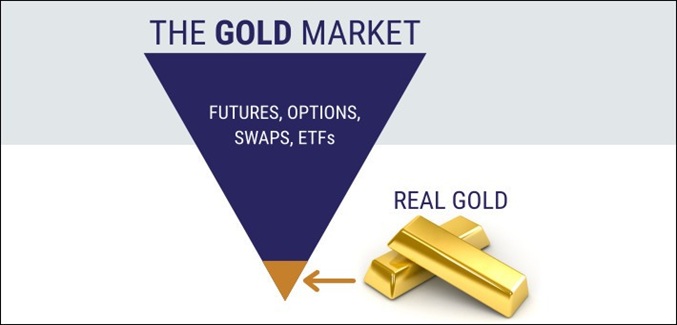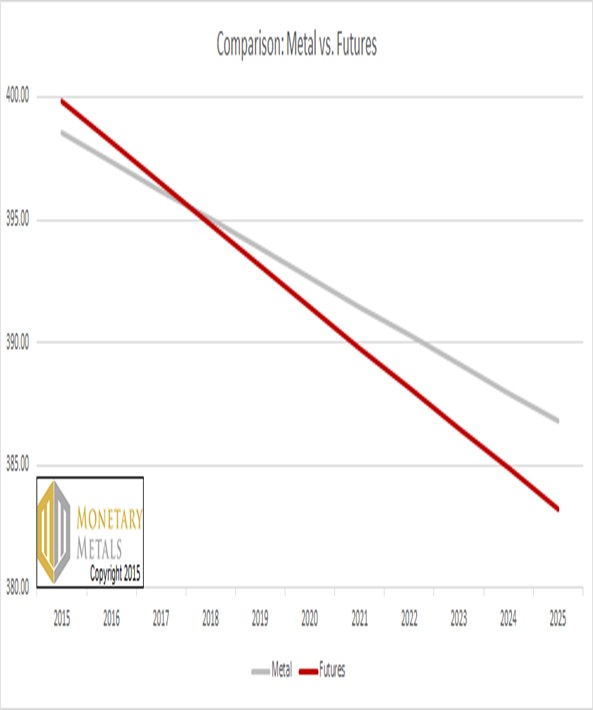The Cost Of Physical Gold vs Futures

Suppose you plan to buy gold, hold it 10 years, and sell it at the end. Is it more cost-effective to buy physical metal, store it, and sell it at the end? Or are you better off buying futures?
It’s easy to calculate the cost of physical metal. If you buy at $4 over spot, that’s about 35 basis points (bps). You will also pay for storage an insurance, say 30 bps per year. In 10 years, you sell it at the spot price. Your total cost is about 3.3%. If you started with enough to dollars to buy 400oz of gold, then at the end you would have dollars equal to about 386.8oz at the then-current price of gold.
Futures contracts are more complicated. When you buy, there is almost no premium (10 or 20 cents). However, there is a commission of around $0.25 an ounce. So initially, you get more gold.
See the graph above, zoomed in to show the small difference in cost between the two approaches to holding gold for 10 years and then selling it.

However, the cost of holding the position is greater. This is because the price of longer-dated contracts is higher—called contango. Contango represents the majority of your cost if you hold for a long period of time like 10 years.
There’s a simple reason why contango is normal in the gold market. Contrary to popular belief, the typical seller of a gold contract is not betting on a falling gold price. He is an arbitrageur. He is earning a small spread between the price of gold in the spot market and the price in the futures market. He simultaneously buys metal and sells a contract, storing the gold in the meantime. This is called carrying gold. The cost of carry is mostly interest expense. So generally, the price of a future should be above the price of spot by the amount of this interest.
Not too long ago, the contango in gold was about 80 bps. It’s now about 25 bps (which suggests the market has become tight, but that’s a whole separate discussion). This is your cost to hold futures contracts.
For example, a gold contract for Dec 2016 delivery is a little over a year until maturity. Instead of paying spot—say $1,135—you will pay about $4 over spot.
Unfortunately, when December 2016 comes around, you will have to sell the contract and buy another one that’s farther out—called rolling the contract. Rolling costs you another commission.
Also, that premium you paid will have wasted away. When it comes time to sell, you will be lucky to get the spot price. That’s because in our new normal world, gold futures tend to go into backwardation as they approach expiration. Backwardation, the opposite of contango, is when a futures contract trades below the spot price. Selling a backwardated contract costs you more—about 80 cents for the December 2015 contract right now.
Currently, you’re looking at a loss of about $5 when you roll a contract forward one year. To hold futures for 10 years, you have to do this 9 times. Assuming the costs remain the same (they won’t), you will have about a 4.4% loss by the end. To exit your position, you simply sell the last contract but don’t buy the next year.
You end up with a total dollar amount worth about 382.6oz of gold. Remember from above, with gold bars, it’s about 386.8oz. It’s pretty close at the moment, though futures come out behind. And this is with futures being a lot cheaper than normal (due to the tightness I mentioned above). If the market corrects this condition, the cost of using futures could go a lot higher.
There are more complex ways to play with futures. If you’re sophisticated and have a bit of luck, you could end holding your gold exposure at zero or even make a profit. However, this approach is not for most people.
There is one other advantage to physical metal over futures. Futures have counterparty risk. You are extending credit. For a short time frame, I wouldn’t worry about it too much. However for a 10-year period, there is a risk that gold could go into permanent backwardation . In that case, futures contracts could become worthless.
********
Monetary Metals and the Perth Mint are sponsoring a seminar in Sydney on Oct 28, to discuss economics and markets, with a focus on how to approach saving, investing, and speculating. Please register here.






 Dr. Keith Weiner is the CEO of Monetary Metals and the president of the
Dr. Keith Weiner is the CEO of Monetary Metals and the president of the 









